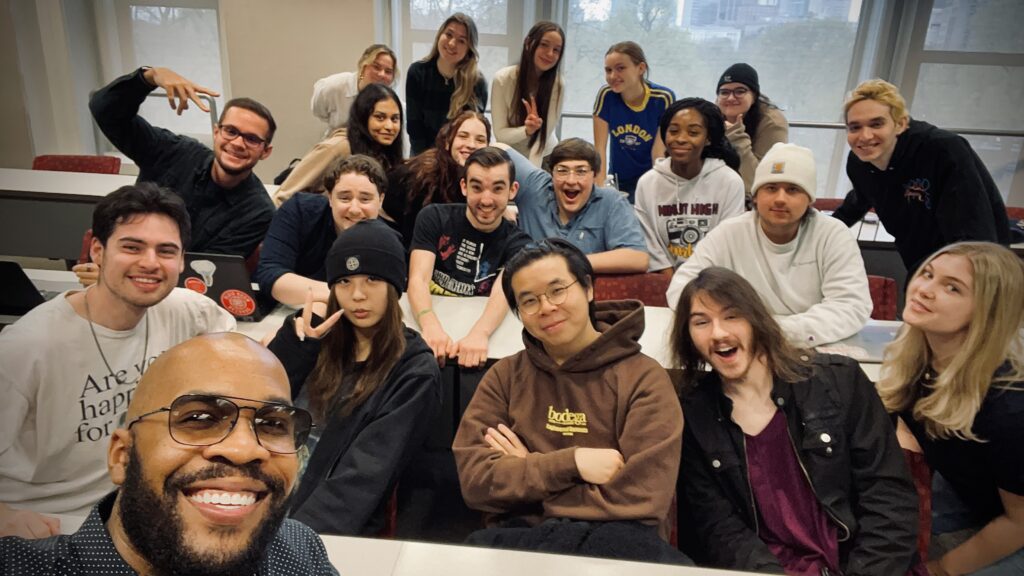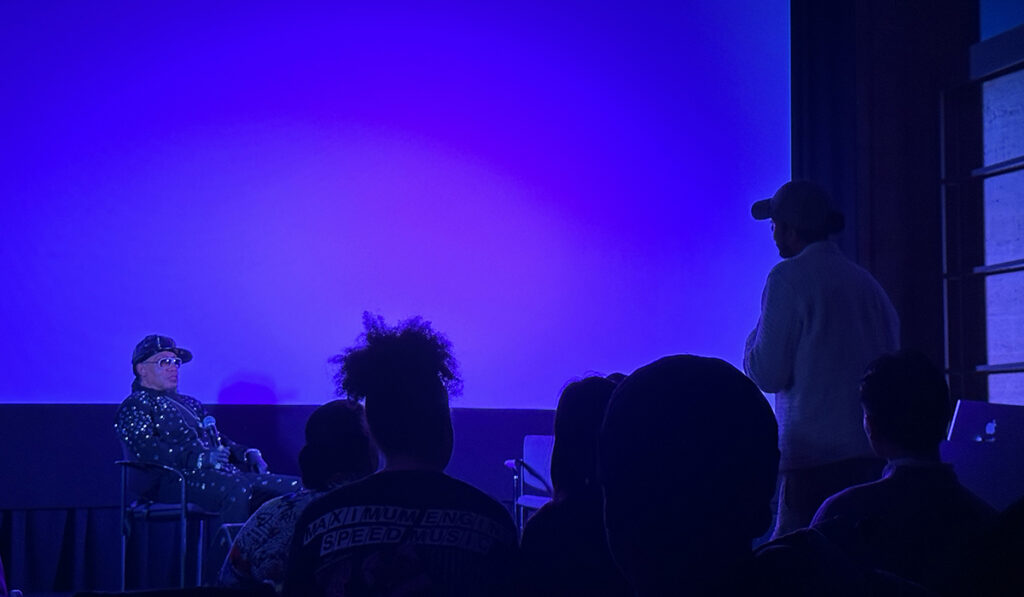Emerson Celebrates 50 Years of Hip Hop’s Cultural, Economic Impact

The 50th anniversary of Hip Hop this month provides an opportunity to celebrate the influence of the genre on Emerson and the global musical landscape. But it’s also a chance to explore how the entrepreneurial culture surrounding the music has impacted our economy and other sectors.
Jae Williams ’08, MA ‘16, executive-in-residence for the Business of Creative Enterprise (BCE) program, created the course Hip Hop Culture & The New Economy, which was first offered last spring. He believes that it’s important for students, and others, to know Hip Hop beyond the cultural influence of the genre.
“It’s important to understand the economic impact of Hip Hop culture. … Money is the bottom line. We’re in a capitalistic society,” said Williams. “To just discuss Hip Hop as a cultural phenomenon, and to not talk about profitability and its influence on the economy, you’re missing the point of how important Hip Hop is, to not only artists, but also to people who consume it.”
In addition, talking about Hip Hop without discussing race, religion, and politics, feels incomplete for Williams. In class, he asks students to consider the idea that one Hip Hop pioneer was an American president, which usually creates a lot of confused looks.
“In the 1930s, there was the Great Depression. Franklin Delano Roosevelt created the New Deal. The New Deal laid the groundwork for mortgages. Mortgages created space for public housing,” said Williams, connecting the dots.
“Public housing was first built in 1934. Fast forward to 1973, and Hip Hop was birthed by two teenagers: [DJ Kool Herc] Clive and Cindy Campbell, at 1520 Sedgewick Avenue [which is historically accepted as the birthplace of Hip Hop] in the Bronx – a public housing project. They didn’t know they were creating a cultural phenomenon. They were just trying to get money for school clothes. And here we are.”
Williams also shares with students Hip Hop culture’s influences on their day-to-day activities and how it created a new economy. The term “new economy” is referenced in the book The Tanning of America: How Hip Hop Created a Culture, by Steve Stoute, a record executive, entrepreneur, and CEO of the marketing company Translation. “Tanning” is a term Stoute coined that describes the mental complexion of a consumer, a notion Williams discusses in class.
“In America, advertising, marketing, branding, product consumption, have traditionally been based on demographics: Blacks want this, Whites want this, and Asians want that. That’s not a thing anymore,” said Williams. “People invest and buy things based upon their shared values, not based upon demographics.”
The consumer economy has changed to be more inclusive, and Hip Hop reflects that change.
“It [used to be], you’re only going to like this because you live in this city, or this is your age, or you identify as this race – so this has to fit you,” said Williams. “It was forcing people to go into a box they didn’t know they were going into.
“But you don’t have to be Latino to like Latino food. You don’t have to be Asian to like Chinese food. And you don’t have to be Black to go to Hip Hop concerts,” said Williams. “[I’m there] because I enjoy the culture and the conversation, the moral ecosystem of that particular economy.”
WERS Celebrating with Music, Blogs, and More
Emerson and its flagship radio station, WERS, embraced Hip Hop back in the 1980s, and continue to do so in several ways.
WERS kicked off its anniversary celebration of Hip Hop in November 2022, when General Manager Howard “D” Simpson interviewed Melle Mel, who wrote the seminal Hip Hop track, “The Message,” and came to Emerson to commemorate the 40th anniversary of its release.
“It was such an honor to meet and talk to a legend about his contributions to Hip Hop’s early days,” said Simpson.
Since then, notable Hip Hop artists such as Tupac Shakur, Biz Markie, and Busta Rhymes have been spotlighted by blog articles on WERS.org. The profiles are converted into one-minute recorded bios that air on the station’s 24/7 R&B and Hip Hop streaming channel, WERSPlus.org (ERS+). Each piece is followed by a three- or four-song playlist of the featured artist for the month.

“One of the best exploratory highlights was in March, when we celebrated International Women’s Day for the entire month,” said Simpson. “Our focus was on the ‘Leading Ladies of Hip Hop’: Roxanne Shante, Salt N Pepa, Queen Latifah, MC Lyte, and Lauryn Hill. It’s been said that Hip Hop tells the story of young Black America. That being the case, it can’t be told by men alone.”
WERS used to air “88.9 at Night” from the 1980s to 2013, and the tradition lives on through ERS+, said Simpson.
“We give you Drake, we give you Kendrick Lamar, but dive deeper to also give you Run-D.M.C., Kurtis Blow, Whoodini, and the other pioneers who passed the mic to them. ERS+ really is a cultural experience that hits different,” said Simpson
Simpson said Emerson has another great opportunity celebrate Hip Hop in its partnership with BAMS Fest to offer live performances on the UnCommon Stage.
Toki Wright, community partnerships and programs manager for BAMS Fest said the story of Hip Hop is the story of “reinvention, history, creative practice, community development” and more.
“It is important to celebrate Hip Hop on the UnCommon Stage because so many Hip Hop artists feel excluded from being able to freely express themselves in public spaces,” Wright said. “Hip Hop also allows us to see and hear the breadth and depth of our multifaceted community.”
The impact of Hip Hop over the decades has been incredible to watch, Simpson said.
“Hip Hop has always been a cultural movement that included the pillars of dance, fashion, technology [turntables] and artwork [graffiti],” said Simpson. “The fun and sometimes thought-provoking grooves were the centerpiece of what blossomed beyond what I thought possible back when I was buying 45s, 12-inches and cassettes from Skippy Whites in Mattapan Square. Today, Hip Hop is a multi-billion dollar industry.”
UnCommon Stage Schedule Thursday, August 17 5-6 pm: Ju$t Jill 7-8 pm: Russell Gutta Ferguson Thursday, August 24 7-8 pm: SeeFour Thursday, August 31 5-6 pm: Hip Hop Trivia with Dart Adams and Toki Wright 6-7 pm: Najee Janey 7-8 pm: Brandie Blaze
Crossing Industries

One original group captured on those cassette tapes Simpson was buying in the ’80s was Run-D.M.C. The group and their affiliation with Adidas was one of the first instances of Hip Hop culture crossing cultural barriers, backgrounds, industries, and catapulting into the mainstream.
“Before Run-D.M.C., Adidas was about athletes and soccer players, and creating the best equipment for the avid soccer player,” said Williams.
Then Run-D.M.C. recorded the song and video, “My Adidas,” wearing Adidas track suits and shoes with fat laces or no laces at all. At a concert in Madison Square Garden, members of the group held up their sneakers to the crowd, and hundreds of people in the audience took off their Adidas and held them up, said Williams. Seeing an opportunity, Hip Hop record label executive and Def Jam co-founder Russell Simmons parlayed that popularity into a $1.6 million endorsement deal and a long-term relationship with Adidas.
Simmons went on to become more than a record label co-founder. He was an entrepreneur and created several fashion labels, including one of the first popular Hip Hop fashion lines, Phat Farm.
The path Simmons blazed was then followed by people like Hip Hop mogul Sean “Puff Daddy/Diddy” Combs, who created his own record label (Bad Boy Records), his own fashion line (Sean John), and monetized his popularity through other revenue streams, such as partnering with alcohol producers.
The marketing of Hip Hop culture showed how industries can coalesce, says Williams. Previous musical genres didn’t permeate other industries like Hip Hop has over the past 50 years. Today, artists sell alcohol, they produce social media content, they give TED Talks and appear on TV shows and films.
“It’s because our economy has shifted,” Williams said. “Consumers want more because they want to be invested in that human being, and not invested in particular demographics. Hip Hop has allowed that shift because it embraced a lot of industries and that made them cool.”
Simpson said the very best MCs transitioned from the recording studio to the small screen, and to the movie studio.
“I trip out when thinking Snoop Dogg had a TV show with Martha Stewart. Never saw that coming. I certainly didn’t expect Snoop to go from Crook to Cook by authoring his own cookbook,” said Simpson.
“Queen Latifah is an Oscar-nominated actress whom I met at a concert at the very start of her career. Her debut release was recently inducted into the National Recording Registry of the Library of Congress. Will Smith and DJ Jazzy Jeff won the first Hip Hop Grammy Award, then went on to gain more exposure through the TV series, The Fresh Prince of Bel Air. That show was broadcast decades before Will became an Oscar winner after multiple nominations.”
Hip Hop modeled a spirit of “hustle,” Williams said.
“Swagger, hustling, and grinding – that was all fueled by Hip Hop culture. And that came from survival. They’re just trying to feed their family…Then they’re trying to make a million, and then a billion,” said Williams.
Music in the Board Room
Before Hip Hop, musicians might be the face of marketing campaigns, but they weren’t the owners of the companies being marketed. Run-D.M.C. was associated with Adidas, but they didn’t own the athletic apparel company. Hip Hop changed that game, as artists such as Dr. Dre created companies like Beats, Williams said.
Professional athletes were wearing Beats headphones during practice, before games, and at the mic stand after game pressers – and that made the average consumer want their own. Apple acquired Beats, and Dr. Dre became a billionaire.
Another example Williams offers is Hip Hop star-turned-cosmetics mogul Rihanna performing at the Super Bowl halftime show earlier this year.
That wouldn’t have occurred if it were not for the partnership formed in 2020 between Jay-Z’s Roc Nation company and the NFL, which gave Jay-Z influence over the league’s most important music events, including the halftime show.
Jay-Z’s rise to stardom and power exhibits the entrepreneurial spirit – going from slinging drugs on New York City streets to a globally and culturally influential billionaire who decides who performs on one of the biggest stages in the world.
“[Jay-Z and the NFL asked] how do we use our counterculture spirit of Hip Hop and infuse that into the biggest stage in America? They did it incredibly successfully with one of the most-watched Super Bowl halftime shows. It speaks to the power of Hip Hop culture,” said Williams.
Simpson said no one has had a better economic blueprint than billionaire investor Jay-Z.
“He started out as a part of a duo with Jaz (“Hawaiian Sophie” anyone?) before going solo. Now he’s a Hip Hop billionaire on the strength of his savvy investing,” said Simpson. “Rocawear with clothing, Tidal in music streaming, and Uber, are among the familiar brands that grew his net worth.”
It’s no longer just about the music. It’s about the new mixtape, the newest kicks, the new club, particular vacation destinations, or the new hot car, said Williams. That, in turn, creates shared interests and consumer desires. It starts with an intimate friend group and snowballs into a full-scale phenomenon, he said.
“It’s people from all different age groups, from different neighborhoods, different cities, and different cultural backgrounds. They adopt a product, and then it’s regional, then it’s the East Coast, then national, and then global,” Williams said. “That is the beginning of the crossover of shared values and how that turns into dollars.”
Categories